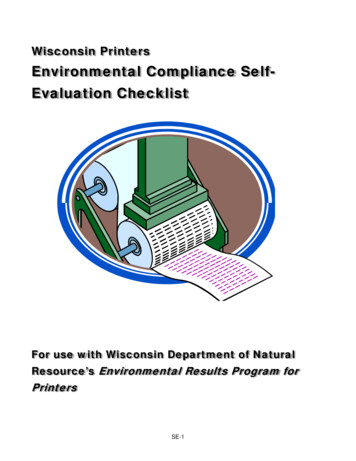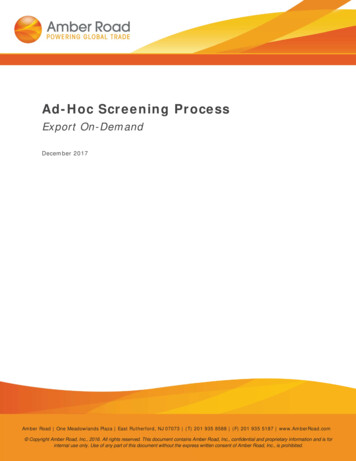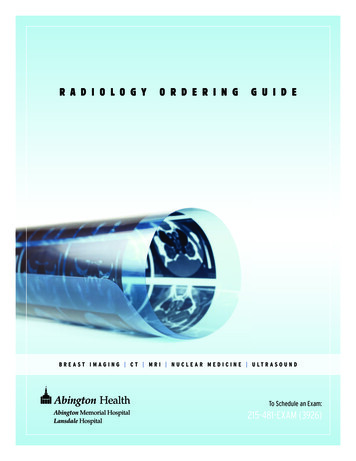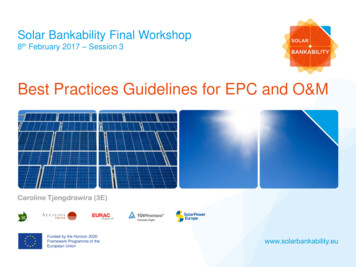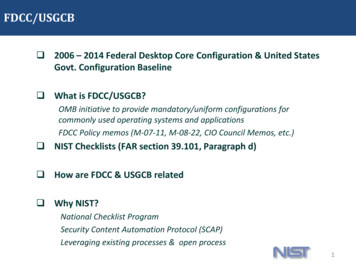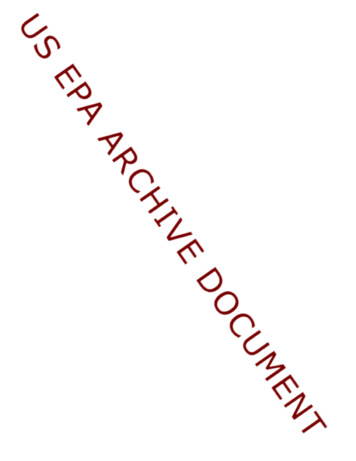
Transcription
DisclaimerThe environmental screening checklist and workbook are tools to beused to help you evaluate compliance at your facility. They do notcontain an exhaustive list or description of all federal environmentalregulations that may apply to your facility. In addition, your facilityis responsible for knowing and complying with all applicable state,local, and tribal requirements.Environmental Screening Checklistand Workbook for the Trucking IndustryAugust 2000W- i
Table of ContentsTABLE OF CONTENTSINTRODUCTION . . . . . . . . . . . . . . . . . . . . . . . . . . . . . . . . . . . . . . . . . . . . . . . . . . . . . . . . . . .How Can I Use the Checklist and Workbook? . . . . . . . . . . . . . . . . . . . . . . . . . . . . . . .How Are the Checklist and Workbook Organized? . . . . . . . . . . . . . . . . . . . . . . . . . . .Where Can I Get Help? . . . . . . . . . . . . . . . . . . . . . . . . . . . . . . . . . . . . . . . . . . . . . . . .W - iiiW - iiiW- vW - viCHECKLISTSECTION 1.01.11.21.31.41.51.61.71.81.9WASTE MANAGEMENT . . . . . . . . . . . . . . . . . . . . . . . . . . . . . . . . . . . . . . . . .Hazardous Waste Generation, Storage and Transport . . . . . . . . . . . . . . . . . .Used Oil and Filters . . . . . . . . . . . . . . . . . . . . . . . . . . . . . . . . . . . . . . . . . . . . .Used Antifreeze . . . . . . . . . . . . . . . . . . . . . . . . . . . . . . . . . . . . . . . . . . . . . . . .Used Battery Storage and Disposal . . . . . . . . . . . . . . . . . . . . . . . . . . . . . . . .Used Shop Rags/Towels . . . . . . . . . . . . . . . . . . . . . . . . . . . . . . . . . . . . . . . . .Absorbents . . . . . . . . . . . . . . . . . . . . . . . . . . . . . . . . . . . . . . . . . . . . . . . . . . .Used Tires . . . . . . . . . . . . . . . . . . . . . . . . . . . . . . . . . . . . . . . . . . . . . . . . . . . .Brake Repair . . . . . . . . . . . . . . . . . . . . . . . . . . . . . . . . . . . . . . . . . . . . . . . . . .Metal Machining . . . . . . . . . . . . . . . . . . . . . . . . . . . . . . . . . . . . . . . . . . . . . . .W-1W-1W-9W-15W-18W-20W-22W-23W-24W-26SECTION 2.0 WASTEWATER AND STORM WATER MANAGEMENT . . . . . . . . . . . . . . . . . W-282.1Wastewater and Storm Water Management . . . . . . . . . . . . . . . . . . . . . . . . . . W-282.2Activities Generating Wastewater and/or Storm Water . . . . . . . . . . . . . . . . . . W-34SECTION 3.03.13.23.33.43.53.63.73.83.93.10MAINTENANCE ACTIVITIES . . . . . . . . . . . . . . . . . . . . . . . . . . . . . . . . . . . . . .Equipment Cleaning and Spent Solvents . . . . . . . . . . . . . . . . . . . . . . . . . . . .Fueling . . . . . . . . . . . . . . . . . . . . . . . . . . . . . . . . . . . . . . . . . . . . . . . . . . . . . .Asbestos Concerns - Building Renovation/Demolition . . . . . . . . . . . . . . . . . . .Construction Activities . . . . . . . . . . . . . . . . . . . . . . . . . . . . . . . . . . . . . . . . . . .Pesticide Use . . . . . . . . . . . . . . . . . . . . . . . . . . . . . . . . . . . . . . . . . . . . . . . . .On-Site Waste Disposal of Nonhazardous Waste . . . . . . . . . . . . . . . . . . . . . .Yard Dust Control . . . . . . . . . . . . . . . . . . . . . . . . . . . . . . . . . . . . . . . . . . . . . .Painting/Paint Removal . . . . . . . . . . . . . . . . . . . . . . . . . . . . . . . . . . . . . . . . . .PCB-Containing Equipment . . . . . . . . . . . . . . . . . . . . . . . . . . . . . . . . . . . . . . .Air Conditioning Repair . . . . . . . . . . . . . . . . . . . . . . . . . . . . . . . . . . . . . . . . . ON 4.0 STORAGE TANKS, SPCC, and EMERGENCY RESPONSE . . . . . . . . . . . . .4.1Underground Storage Tanks (USTs) . . . . . . . . . . . . . . . . . . . . . . . . . . . . . . . .4.2Aboveground Storage Tanks (ASTs) . . . . . . . . . . . . . . . . . . . . . . . . . . . . . . .4.3Spill Prevention, Control, and Countermeasures (SPCC) andEmergency Response . . . . . . . . . . . . . . . . . . . . . . . . . . . . . . . . . . . . . . . . . . .W-63W-63W-65RECORDKEEPING . . . . . . . . . . . . . . . . . . . . . . . . . . . . . . . . . . . . . . . . . . . .NPDES Recordkeeping . . . . . . . . . . . . . . . . . . . . . . . . . . . . . . . . . . . . . . . . . .Recordkeeping for Air Emissions . . . . . . . . . . . . . . . . . . . . . . . . . . . . . . . . . .RCRA Recordkeeping . . . . . . . . . . . . . . . . . . . . . . . . . . . . . . . . . . . . . . . . . . .Recordkeeping for Underground Storage Tanks . . . . . . . . . . . . . . . . . . . . . .Records of Pesticide Application . . . . . . . . . . . . . . . . . . . . . . . . . . . . . . . . . . .W-71W-71W-72W-73W-74W-77GLOSSARY OF TERMS . . . . . . . . . . . . . . . . . . . . . . . . . . . . . . . . . . . . . . . . . . . . . . . . . . . . .G -1SECTION 5.05.15.25.35.45.5Environmental Screening Checklistand Workbook for the Trucking IndustryW-67August 2000W- ii
IntroductionINTRODUCTIONThe United States Environmental Protection Agency (EPA) is providing the EnvironmentalScreening Checklist and Workbook for the Trucking Industry as a public service to the truckingindustry. EPA’s Office of Compliance, through various meetings with industry representatives,facility owners, and technicians, determined there is a need for clear information for facilities tohelp them attain or remain in compliance with applicable federal environmental regulations.The checklist and workbook highlight important or key environmental requirements as theyapply to the various federal environmental programs.HOW CAN I USE THE CHECKLIST AND WORKBOOK?You can use the checklist and workbook to evaluate your facility’s compliance with the federalenvironmental regulations which are applicable to the trucking industry. The term facility refersto , but is not limited to, trucking terminals, truck maintenance shops, etc. overseen byowners/operators, managers, field personnel, etc. who engage in trucking operations. Ifproblems with compliance are discovered while completing the checklist, you may want toconduct a more comprehensive self-audit.You can use the checklist and workbook to evaluate the compliance of either specific activitiesor areas of your facility or your entire facility. Specific areas of your facility that you may wantto review are shown in Exhibit 1. This exhibit, “Index of Activities and Requirements for theTrucking Industry,” is a pictorial representation of specific activities that are regulated or specificenvironmental requirements at a trucking facility. A page reference is included next to eachactivity/requirement which takes you to the appropriate section of the workbook where this topicis discussed. In addition, this exhibit also includes hotlines that you can contact to obtain moreinformation on applicable environmental requirements. As indicated on the exhibit, one goodsource of environmental information for the transportation sector is the TransportationEnvironmental Resource Center (TERC). You can reach TERC to request more information onenvironmental issues or get answers to your transportation-related environmental questions byphone or on the world wide web:TERC Toll-Free Info-Line: 1-888-459-0656TERC Internet Address: http://www.transource.orgPlease remember that all of these materials are a beginning, not the final word, onenvironmental compliance requirements. While federal environmental requirements arehighlighted in the checklist and workbook, a comprehensive discussion of all requirements isNOT included. In addition to federal requirements, you may be subject to state, tribal, and/orlocal requirements. You can use these materials to build a basic understanding or increaseyour knowledge of federal environmental requirements, and then seek additional assistancefrom various federal, state, tribal, and local agencies.Environmental Screening Checklistand Workbook for the Trucking IndustryAugust 2000W- iii
IntroductionThis page reserved forExhibit 1. Index of Activities and Requirements for the Trucking IndustryEnvironmental Screening Checklistand Workbook for the Trucking IndustryAugust 2000W- iv
IntroductionHOW ARE THE CHECKLIST AND WORKBOOK ORGANIZED?What Is Included? Following this introductory section are the checklist and workbook.These materials include the following sections:CCCCCSection 1.0Section 2.0Section 3.0Section 4.0Section 5.0Waste ManagementWastewater and Storm Water ManagementMaintenance ActivitiesStorage Tanks, SPCC, and Emergency ResponseRecordkeepingFollowing these five sections, a glossary is provided for your use.Where Do I Start? You may first want to become familiar with the workbook because it is morecomprehensive than the checklist in terms of environmental compliance information and issues.Once you have become familiar with the workbook, you can use the checklist by itself toconduct a compliance evaluation of your facility.The two page checklist, located after this introductory text, is basically a streamlined version ofthe workbook and has been included to help make the evaluation of your facility’s complianceas easy and efficient as possible. Because the checklist was designed to evaluate specificactivities and requirements at your operation, it does NOT include all of the questions oractivities found in the workbook.Each checklist question will ask you about key environmental requirements that are applicableto a trucking facility. After reading each question, pick the most appropriate response for yourfacility. If you are unsure of what is being asked by the question or what a response meanswhen using the checklist, refer to the same question in the workbook. The workbook includessome general explanatory text foreach question, as well asexplanations of each response. AW HAT DOES THE “U” MEAN?“U” next to a response in theA “U” next to a response in the guide indicates thatworkbook indicates that it is ais the preferred response in terms ofpreferred response in terms ofenvironmental compliance. If you select aenvironmental compliance (seeresponse without a “U”, you may still be inbox). The use of the workbook iscompliance. However, you should verify that youencouraged as it will help you andare in compliance by contacting the appropriateothers at your facility conductingfederal or state regulatory agency and discussingevaluations to consistently andyour activity with them.accurately respond to thecompliance questions.Can the checklist be personalized? The checklist can be personalized to fit the needs of yourfacility. When evaluating environmental compliance, you or the person conducting theevaluation should record certain information on the checklist, including the date, name of thefacility, name of the person conducting the evaluation, and any comments or questionsregarding the compliance evaluation. Such information will help you monitor your facility’scontinued progress towards environmental compliance.Environmental Screening Checklistand Workbook for the Trucking IndustryAugust 2000W- v
IntroductionWHERE CAN I GET HELP?During the evaluation and everyday operation of your facility, you may need to obtain additionalinformation on specific environmental requirements. Many resources are available to you whichcan provide valuable information onfederal environmental requirements,EMERGENCY RESPONSE & ASSISTANCEpollution prevention, and othertopics. Some of these resources,! National Response Center (NRC) - U.S. Coastwhich can be contacted byGuard Oil & Hazardous Material Spills (800-424telephone or accessed through the8802)Internet, include publications,hotlines and information lines, EPA! CHEMTREC operated by ChemicalHeadquarters and regional offices,Manufacturers Association on Health and Safetyfinancial assistance information, and(800-424-9300)pollution prevention websites.Publications ! Environmental Health Effects: (National Instituteof Health) Information on chemicals in ground andsurface water, hazardous wastes (800-643-4794)Sector Notebooks. Thefollowing sector notebooks,! Local Emergency Number: 911which may be of interest tothe trucking industry, can bedownloaded electronically at:http://es.epa.gov/oeca/sector/index.html Also copies can be ordered from GPO at(202) 512-1800.SProfile of the Ground Transportation Industry - Railroad, Trucking, and Pipeline,EPA/310-R-97-002 (134 pages)SProfile of the Transportation Equipment Cleaning Industry, EPA/310-R-95-018(81 pages) Transportation Equipment Cleaning Industry Effluent Guidelines and Standards Proposed Rule. EPA is proposing a regulation that will establish technology-basedeffluent limitations guidelines for the discharge of pollutants into waters of the U.S. andinto publicly owned treatment works by existing and new facilities that performtransportation equipment cleaning operations. For more information, call (202) 2604992. Code of Federal Regulation (CFR) References.Website: nes and Information LinesCTransportation Environmental Resource Center (TERC) Information LineTelephone: (888) 459-0656Website: http://www.transource.orgThis resource center is designed to help transportation industries stay on top ofenvironmental requirements and technologies.Environmental Screening Checklistand Workbook for the Trucking IndustryAugust 2000W- vi
IntroductionCAmerican Trucking AssociationsTelephone: (703) 838-1700Website: http://www.greentruck.comATA is a trade association representing trucking interests before government ona wide variety of issues.CAir Risk Information Support Center HotlineTelephone: (919) 541-0888Fax: (919) 541-0245This hotline provides technical assistance and information in areas of health,risk, and exposure assessment for toxic and air pollutants.CEmergency and Remedial Response Fax-On Demand ServiceTelephone: (202) 651-2062This service offers one-way fax documents about Emergency and RemedialResponse programs.CEmergency and Remedial Response InformationTelephone: (703) 603-8960 or (800) 424-9346 (RCRA/UST, Superfund, andEPCRA Hotline below)CEnvironmental Justice HotlineTelephone: (800) 962-6215This hotline provides environmental assistance and information relating toenvironmental justice issues, including brownfields. See “Brownfields” listingunder Pollution Prevention Websites below for more information.CHazardous Waste Generator and RecyclingTelephone: (703) 308-8850This office provides information regarding regulations and guidance concerninghazardous waste generators, including RCRA manifest and the definitions.CHazardous Waste - Permits and State ProgramsTelephone: (703) 308-8404This office provides outreach and coordination of RCRA hazardous wasteprograms implementation, including permitting, clean up and technical approach.CHazardous Waste - Risk Assessment and Economic AnalysisTelephone: (703) 308-8855This office provides toxicology and exposure data; health and ecological riskassessment; and sampling, statistical, and analytical methods.CHazardous Waste InformationTelephone: (703) 308-8482Environmental Screening Checklistand Workbook for the Trucking IndustryAugust 2000W- vii
IntroductionThis office provides RCRA Government Performance Results Act (GPRA)coordination program information collection outreach and guidance.CHazardous Waste PermitsTelephone: (703) 308-8196This office provides information regarding regulations and guidance for RCRAhazardous waste permitting program for waste treatment, storage, and disposal. National Pesticides Information LineTelephone: (800) 858-7378This service provides callers information relating to pesticide usage, includinglabel information, incident investigations, emergency human and animaltreatment safety practices and clean-up and disposal.CNational Response Center Hotline/Oil and Hazardous Material SpillsTelephone: (800) 424-8802 or (202) 267-2675Fax: (202) 267-2165This hotline can be used by callers to report oil and hazardous material spills that(1) violate applicable water quality standards, (2) cause a film or “sheen” uponsurface waters or adjoining shorelines, or (3) cause a sludge or emulsion to bedeposited beneath surface waters or upon adjoining shorelines. This hotline isstaffed 24 hours a day, 7 days a week, by U.S. Coast Guard officers and marinescience technicians.CPollution Prevention Information Clearinghouse (PPIC)Telephone: (202) 260-1023Fax: (202) 260-4659Website: C is a free, non-regulatory service of EPA that provides answers andreferrals in response to questions from the public concerning pollutionprevention.CResource Conservation and Recovery Act (RCRA) InformationTelephone: (415) 744-2074This hotline responds to requests for information on hazardous wasteidentification; generators; transporters; treatment, storage, and disposal facilities;recycling sites; and export and import.CRCRA/Underground Storage Tanks (RCRA/UST), Superfund, and Emergency Planningand Community Right-to-Know (EPCRA) HotlineTelephone: (800) 424-9346 or (703) 412-9810This hotline provides information about the RCRA/UST, Superfund, and EPCRAprograms. Specifically, the hotline responds to inquiries about wasteminimization programs required under RCRA, source reduction and hazardouswaste combustion, and other components of the waste management regulatoryprograms.Environmental Screening Checklistand Workbook for the Trucking IndustryAugust 2000W- viii
IntroductionCSafe Drinking Water HotlineTelephone: (800) 426-4791 or (703) 285-1093Fax: (703) 285-1101E-mail: hotline-sdwa@epamail.epa.govThis hotline provides information about EPA's drinking water regulations andother related drinking water and groundwater topics. Technicians are availableto get details on legislation and regulations or provide important contacts forwater resources and information on drinking water and groundwater.CSmall Business Ombudsman Clearinghouse/HotlineTelephone: (800) 368-5888 or (703) 305-5938Fax: (703) 305-6462This hotline provides regulatory and other environmental information concerningsmall business assistance to enhance voluntary regulatory compliance andpollution abatement and control. It also addresses questions covering all mediaprograms within EPA.CStratospheric Ozone Information HotlineTelephone: (800) 296-1996 or (301) 614-3376Fax: (301) 614-3395This information hotline provides in-depth information on ozone protectionregulations and requirements under Title VI of the Clean Air Act Amendments of1990. In addition, the hotline serves as a distribution center and point of referralfor an array of information pertaining to other general aspects of stratosphericozone protection and depletion.CStorm Water HotlineTelephone: (800) 245-6510This hotline serves as a clearinghouse for information concerning EPA’s stormwater general permits. Information specialists are available to answer technicalquestions concerning permit eligibility, specific permit requirements, and provideguidance materials.CToxic Substances Control Act (TSCA) Assistance Information ServiceTelephone: (202) 554-1404Fax: (202) 554-5603The information service provides technical assistance and general informationabout programs implemented under TSCA, including inquiries aboutimport/export of chemicals under the regulatory program.Environmental Screening Checklistand Workbook for the Trucking IndustryAugust 2000W- ix
IntroductionCUnderground Storage TanksTelephone: (703) 603-9900Website: http://www.epa.gov/OUST/This office directs callers on where to obtain information regarding undergroundstorage tanks.CUsed Filter HotlineTelephone: (800) 99-FILTER (993-4583)Website: http://www.filtercouncil.orgThis hotline, sponsored by the Filter Manufacturers Council, provides commercialgenerators of used oil filters with a summary of the state’s filter managementregulations, referrals to companies that provide filter management services,referrals to state agencies, and a brochure entitled “How to Choose a FilterManagement Service.”CWetlands Information HotlineTelephone: (800) 832-7828 or (703) 748-1304This information line answers questions concerning the value and function ofwetlands and options for their protection, and accepts requests for certainwetlands publications.EPA Headquarters and Regional Office Information EPA HeadquartersTelephone: (202) 260-1090Fax: (202) 260-0279Website: http://www.epa.gov/ Region 1 (CT, MA, ME, NH, RI, VT)Telephone: (617) 918-1111Toll-free: (888) 372-7341Website: http://www.epa.gov/region1/ Region 2 (NJ, NY, PR, VI)Telephone: (212) 637-3000Website: http://www.epa.gov/region2/ Region 3 (DC, DE, MD, PA, VA, WV)Telephone: (215) 814-5000Toll-free: (800) 438-2474Website: http://www.epa.gov/region3/ Region 4 (AL, FL, GA, KY, MS, NC, SC, TN)Telephone: (404) 562-9900Toll-free: (800) 241-1754Website: http://www.epa.gov/region4/ Region 5 (IL, IN, MI, MN, OH, WI)Telephone: (312) 353-2000Environmental Screening Checklistand Workbook for the Trucking IndustryAugust 2000W- x
IntroductionToll-free: (800) 621-8431Website: http://www.epa.gov/region5/ Region 6 (AR, LA, NM, OK, TX)Telephone: (214) 665-2200Toll- free: (800) 887-6063Website: http://www.epa.gov/region6/ Region 7 (IA, KS, MO, NE)Telephone: (913) 551-7003Toll- free: (800) 223-0425Website: http://www.epa.gov/region7/ Region 8 (CO, MT, ND, SD, UT, WY)Telephone: (303) 312-6312Toll-free: (800) 227-8917Website: http://www.epa.gov/region8/ Region 9 (AZ, CA, HI, NV)Telephone: (415) 744-1305Website: http://www.epa.gov/region9/ Region 10 (AK, ID, OR, WA)Telephone: (206) 553-1200Toll-free: (800) 424-4372Website: http://www.epa.gov/region10/Financial Assistance Information Small Business Improvement LoansWebsite: http://www.GetSmart.comGetSmart.com is a leading financial search engine allowing consumers tocompare different loan products from multiple lenders in a single location. Thewebsite’s search engine matches the borrower’s financing preferences withlenders who are pre-screened and ready to fulfill their requests.Pollution Prevention Websites EPA’s Home PageWebsite: http://www.epa.govThis site provides information about EPA offices, programs and initiatives, andregulations. EPA’s Compliance Assistance CentersWebsite: http://es.epa.gov/oeca/mfcac.htmlThis site provides links to EPA’s Compliance Assistance Centers.Environmental Screening Checklistand Workbook for the Trucking IndustryAugust 2000W- xi
Introduction EPA’s Pollution PreventionWebsite: http://www.epa.gov/opptintr/p2home/EPA’s pollution prevention (P2) site includes general P2 information andpublications, information on P2 in the regulations, the definition of P2 as definedunder the Pollution Prevention Act of 1990, and information about voluntary P2programs. There are also links to EPA and non-EPA P2 sites. EPA’s Office of Pollution Prevention and Toxics (OPPT)Website: http://www.epa.gov/opptintr/index.htmlThis site provides access to federal publications, OPPT programs and initiatives,and other information sources related to pollution prevention. EPA’s Office of Underground Storage TanksWebsite: http://www.epa.gov/OUST/This site provides access to federal publications and links to other resourcesabout preventing pollution from underground storage tanks containing petroleumor hazardous substances. EPA’s Oil ProgramWebsite: http://www.epa.gov/oilspillThis site contains comprehensive information on oil spill prevention,preparedness, and response. EPA’s BrownfieldsWebsite: ��s Office of Solid Waste and Emergency Response’s Brownfields siteprovides information about projects and initiatives, tools, contacts, publications,and other information regarding Brownfields. Chemical Emergency Preparedness and Prevention OfficeWebsite: http://www.epa.gov/ceppo/This site provides information regarding hazardous and extremely hazardoussubstances, including planning and reporting requirements. EPA’s Enviro en eWebsite: http://es.epa.govThis site provides P2 information, as well as a link to the National P2 Roundtabledescribed below. National Fire Protection AssociationWebsite: http://www.nfpa.orgThis site contains information on the National Fire Protection Association codesand standards.Environmental Screening Checklistand Workbook for the Trucking IndustryAugust 2000W- xii
Introduction National Pollution Prevention Roundtable Home PageWebsite: http://www.p2.org/This site provides access to the latest information on legislative and regulatoryP2 developments, National Roundtable publications, state P2 program websites,and a directory of industrial P2 publications. Pollution Prevention Information ClearinghouseWebsite: rated by EPA’s Office of Pollution Prevention and Toxics, this clearinghouseis a free, non-regulatory service that provides telephone reference and referral,document distribution for selected EPA documents, and a special collectionavailable for interlibrary loan. Pollution Prevention CooperativesCoordinated with EPA’s Enviro en e program, these cooperatives provide easyaccess to pollution prevention and cleaner production resources around theInternet. SU.S. Federal Agency Pollution Prevention CooperativeWebsite: http://es.epa.gov/cooperative/federal/SState and Local Government/Business Assistance CooperativeWebsite: ts Alternative Guide (SAGE)Website: http://clean.rti.org/This on-line guide provides pollution prevention information on solvent andprocess alternatives for parts cleaning and degreasing. It also provides accessto EPA’s Air Pollution Prevention and Control Division website. EPA’s Small Business and Self Assessment PoliciesWebsite: http://es.epa.gov/oeca/finalpolstate.pdfThis website contains information on how a facility might qualify for penaltyreductions through self-disclosure.Website: http://es.epa.gov/oeca/sbcp2000.pdfThis website contains information on the Small Business Compliance Policy.Environmental Screening Checklistand Workbook for the Trucking IndustryAugust 2000W- xiii
ENVIRONMENTAL SCREENING CHECKLIST FOR THE TRUCKING INDUSTRYFacility Name:Facility Location:Site Reviewer:Date:1.0 WASTE MANAGEMENT**Y9N9NA 9Y9N9NA 9Does the facility meet all hazardous waste storage (quantity and time) requirements? (p. W-7)Y9N9NA 9How does the facility dispose of its hazardous waste? (p. W-7)Ships haz.waste off site/ Disposesof hazardous waste on-site and is aRCRA-permitted TSDF/Other/NADoes the facility have a written contingency plan or basic contingency procedures in place forresponding to spills and releases of hazardous waste? (p. W-8)Y9N9NA 9Are used oil containers/tanks and associated piping labeled “used oil?” (p. W-10)Are used oil containers/tanks and associated piping leak free?” (p. W-10)Y9Y9N9N9NA 9NA 9Does the facility prevent the mixing of used oil with hazardous waste? (p. W-10)Y9N9NA 9How does the facility manage/dispose of used oil? (p. W-11)Sent off site for recycling / Burnedin on-site space heater / Burned offsite / Other / NAHow does the facility manage/dispose of used oil filters? (p. W-13)Recycle/Srvc.company/Other/NAHow does the facility manage/dispose of used fuel filters? (p. W-14)Recycle /Srvc.company/ Managedas hazardous waste /Other / NAHazardous Waste Does the facility have an EPA hazardous waste generator ID number? (p. W-6)Generation,Storage, andDoes the facility store hazardous waste in appropriate storage containers? (p. W-6)Transport*Used Oil andFilters*Y9N9NA 9Has the facility determined if it generates any antifreeze that is hazardous waste? (p. W-16)Y9N9NA 9Used BatteryStorage andDisposal*If storing used batteries, does the facility protect them from storm water contact?(p. W-19)Y9N9NA 9How does the facility manage/dispose of used batteries? (p. W-19)Return to supplier/ Recycle /Srvc.company/ Sent to Universal wastehandler/ Sent to hazardous wastelandfill/ Other/ NAUsed ShopRags/Towels*How does the facility manage/dispose of used shop rags and towels? (p. W-21)Laundry service / Burned for heat /Other/ NAAbsorbents*Does the facility determine if used absorbents are hazardous before disposal? (p. W-22)Y9How does the facility manage/dispose of used tires? (p. W-23)Resale/Retread/Recycle/Other/NAUsed Antifreeze* In terms of storage, is used antifreeze contained, segregated, and labeled? (p. W-15)Used TiresBrake Repair*N9NA 9How does the facility manage asbestos brake pads and asbestos-containing material (ACM) waste? Recycled off site/ Disposed by(p. W-25)vendor/ EPA-approved disposalsite/ Other/ NA2.0 WASTEWATER AND STORM WATER MANAGEMENTWastewater andStorm rm Water*Can the facility identify the final destination of all its drains? (p. W-29)Y9N 9 NA 9If the facility discharges to a surface water does it have an NPDES permit? (p. W-31)Y9N9NA 9Does the facility have a storm water permit?Y9N9NA 9If Yes, does the facility have a storm water pollution prevention plan (SWPPP)?(p. W-32)Y9N9NA 9If discharging to a municipal sanitary sewer, has the facility notified the Publicly-OwnedTreatment Works (POTW) and received approval for discharges? (p. W-32)Y9N9NA 9If discharging to an underground injection control (UIC) well, does the facility comply with UICprogram requirements? (p. W-33)Y9N9NA 9How does the facility manage the sludge from an oil/water separator? (p. W-34)Off-site disposal as hazardouswaste / Off-site disposal to otherfacility / On-site disposal / NAIf the facility stores materials outside, are they protected from contact with storm water?(p. W-35)Y9N9NA 9
ENVIRONMENTAL SCREENING CHECKLIST FOR THE TRUCKING INDUSTRY3.0 MAINTENANCE ACTIVITIES **If halogenated solvents are used in cleaning equipment, has the facility submitted a notificationreport to the air permitting agency? (p. W-39)Y9How does the facility manage/dispose of spent solvents? (p. W-40)Third party vendor / Permitteddischarge to storm sewers orsurface waters / Sanitary sewerwith POTW approval / O
Environmental Screening Checklist August 2000 and Workbook for the Trucking Industry W- i Disclaimer The environmental screening checklist and workbook are tools to be used to help you evaluate compliance at your facility. They do not contain an exhaustive list or description of all federal environmental regulations that may apply to your facility.
